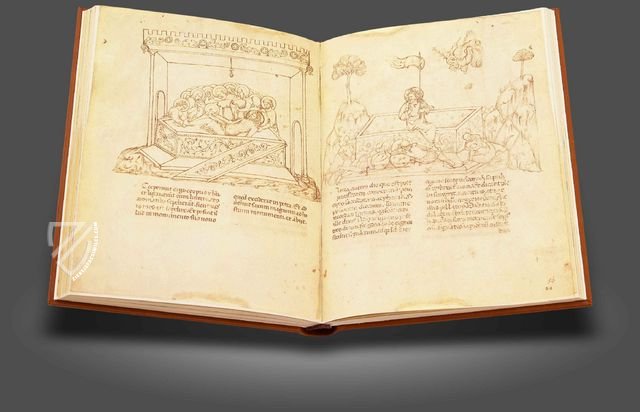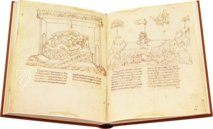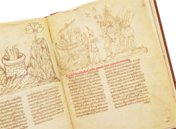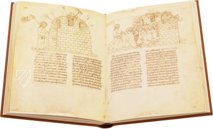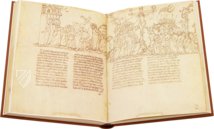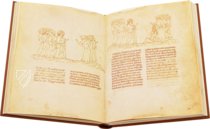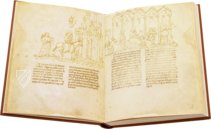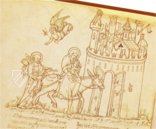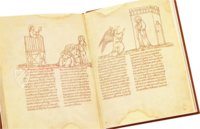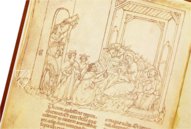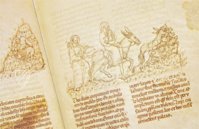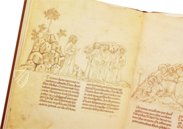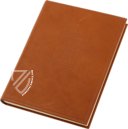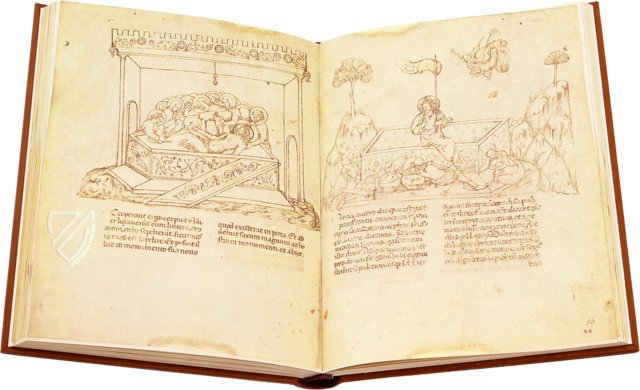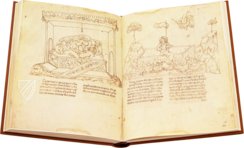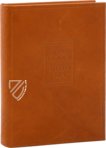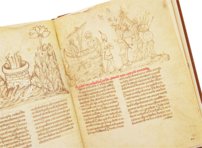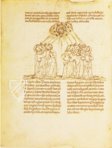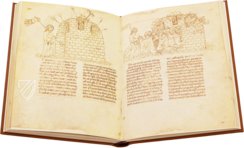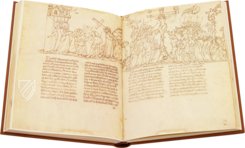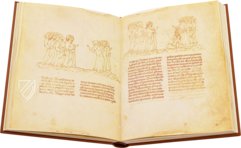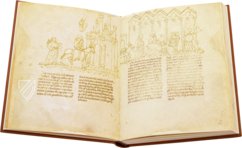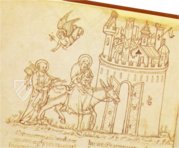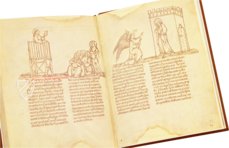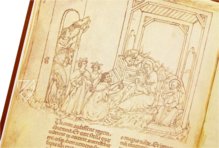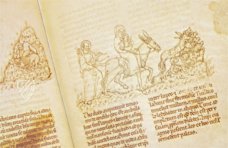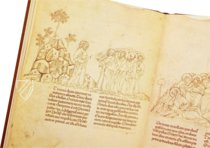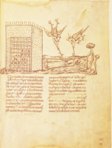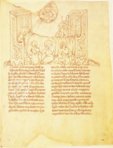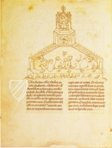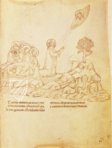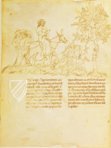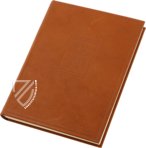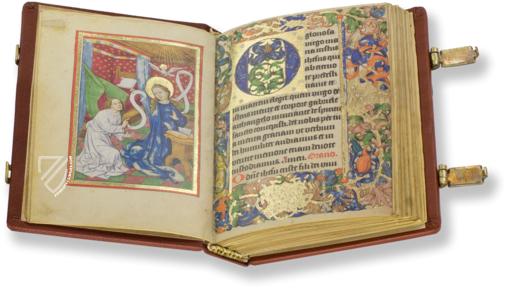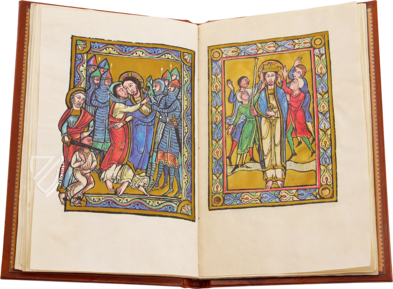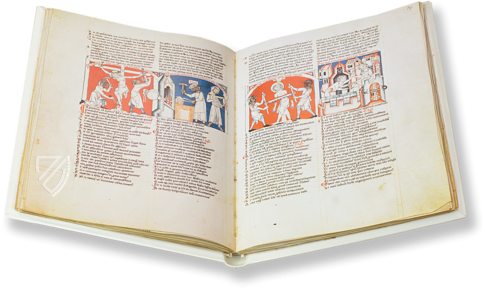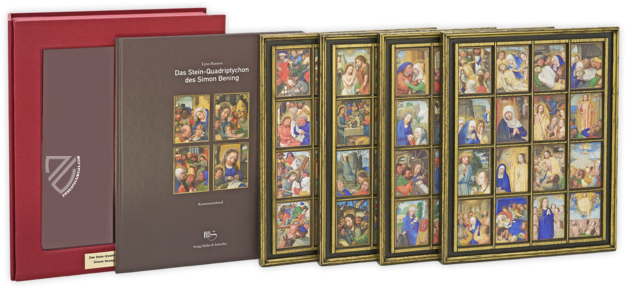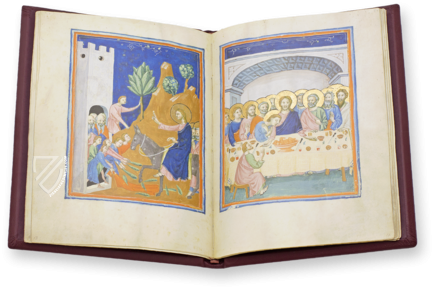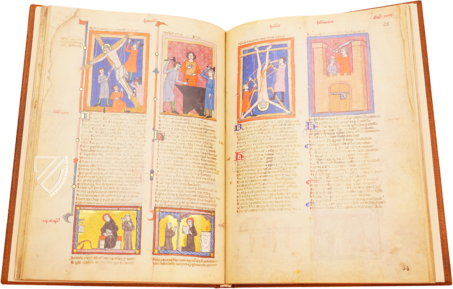Evangelica Historia
(1,000€ - 3,000€)
The Evangelica Historia brings together biblical and apocryphal stories about the life and work of Christ, as well as Mary and her parents, the apostles and Pilate in Latin prose and wonderful large pen and ink drawings of remarkable expressiveness. The 158 surviving miniatures, most of which are about half-page high, captivate with their naturalistic treatment of the figures and countless details in which readers can lose themselves for hours. This beautiful manuscript was probably created for precisely this purpose in the second half of the 14th century. It offers its educated lay readership a comprehensive and homogeneous retelling of the dramatic events of the New Testament, inviting them to meditate on this fundamental period of Christian salvation history. Despite its simplicity, this manuscript is clearly one of the most beautiful and artistic book treasures in the treasury of the Biblioteca Ambrosiana.
Evangelica Historia
The extraordinary manuscript L 58 sup. from the Biblioteca Ambrosiana was produced in the second half of the 14th century. Almost every page was decorated with half-page pen and ink drawings by a truly virtuoso Italian illuminator, although the first pages have unfortunately not survived the centuries. There are 160 remaining pages with a two-column Latin text and 158 miniatures, mostly arranged above it, which are characterized by a captivating dynamic, countless fascinating details, a naturalistic conception of the figures, great expressiveness and wonderful Gothic architecture.
The Life and Work of Christ
Both the text and the images tell of the life and work of Christ, but also of some of the people surrounding him. The basis for the Latin prose text in neat Textura are not only canonical Bible texts, namely the four Gospels and the Acts of the Apostles, but also apocryphal texts, i.e. writings that were not included in the Bible. For example, the Pseudo-Gospel of Matthew was used to integrate stories about Mary and her parents Anna and Joachim, but also from Jesus' childhood, into the text. The end of the manuscript also contains three passages on the Death of Pilate, based on the apocryphal text Mors Pilati, the Destruction of Jerusalem and Mary's Death and Ascension, with each new section identified by a red rubric.
Narrative Images
In the text, all these writings are brought together in a new form in order to present a comprehensive, but at the same time concise and homogeneous narration of the events surrounding Christ's time on earth to an educated lay readership. The images play a decisive role in this. Using common iconography, they visualize the stories, but make them unique with a few artistic twists and details. In the medium of pen and ink drawings, the miniatures' thoughtful detail and lifelikeness are particularly effective. While some scenes are particularly expressive due to their simple composition, others impress with the sheer number of figures, whereby not a single one has been neglected. Christ can be recognized throughout thanks to his Cross Nimbus. In some miniatures, important saints are also hierarchically emphasized by an implied 'embossing' of their halos.
Codicology
- Alternative Titles
- Evangelica historia: disegni trecenteschi del MS. L. 58. SUP. della Biblioteca Ambrosiana
- Size / Format
- 160 pages / 24.0 × 18.0 cm
- Origin
- Italy
- Date
- Second half of the 14th century
- Epochs
- Style
- Language
- Script
- Gothic Textura
- Illustrations
- 158 large, mostly half-page pen and ink drawings
- Content
- Life and work of Christ based on the Gospels and apocryphal texts
- Previous Owners
- Library of the Visconti and Sforza in Pavia
Territorial Abbacy of Saint Mary of Grottaferrata
Evangelica Historia
Adoration of the Three Magi
Mary is sitting with Jesus on her lap in front of a manger, over which a bull and a donkey are leaning. Joseph is seated on a throne-like stool at the right-hand edge of the miniature. The three Magi are about to present their gifts to the Messiah, the foremost of whom is already receiving Christ's blessing. The scene is watched by their three noble steeds. However, one of them has to be held in check by a squire, which brings the biblical story right into the time when the manuscript was created.
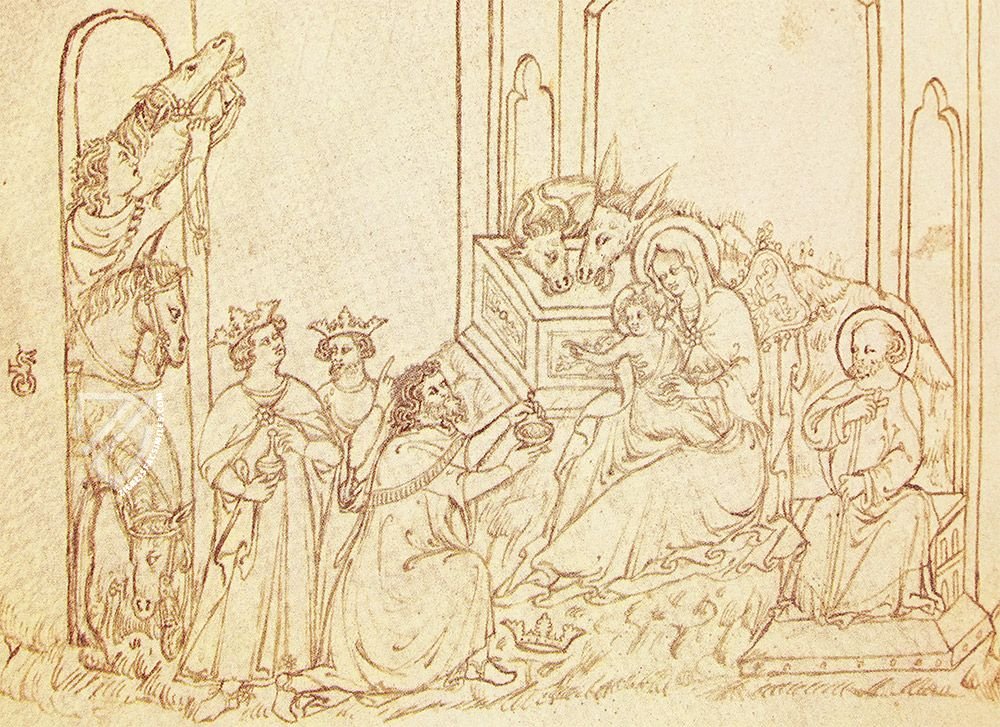
Evangelica Historia
Jesus' Prayer in the Garden of Gethsemane
After the Last Supper, Jesus goes with his disciples to the Mount of Olives, to the Garden of Gethsemane. While he tells them to sit down and keep watch, he withdraws alone into the garden for a prayer – knowing that he is already about to be betrayed by Judas and arrested the next moment. In the Gospel of Mark, the human nature of the Son of God comes to the fore here when he speaks to his Father full of fear: “Abba, Father, all things are possible unto thee; take away this cup from me: nevertheless not what I will, but what thou wilt.” (Mark 14:32)
The miniature for this scene takes up almost two thirds of the page. Eleven disciples – Judas is missing – are crouching asleep on the left-hand side. John can be seen frontally, revealing the ornamental upper side of the halo of Jesus' favorite disciple. Meanwhile, the latter is kneeling and praying to God the Father, whose apparition leans down towards him from a UFO-like cloud in the heavenly sphere.
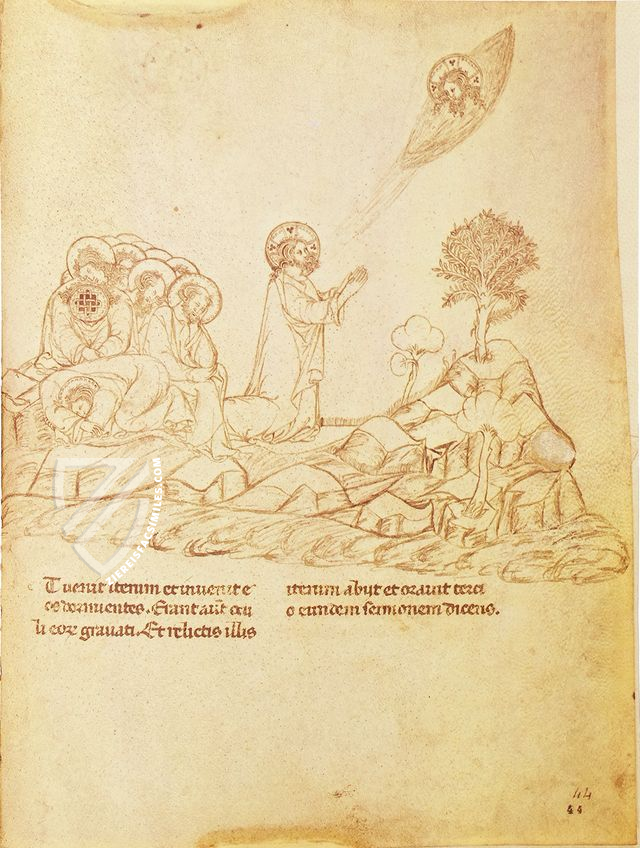
#1 Evangelica historia (Luxury Edition)
Language: Italian
Featuring a transcription and translation of the text by Angelo Paredi.
(1,000€ - 3,000€)
#2 Evangelica historia (Standard Edition)
Language: Italian
Featuring a transcription and translation of the text by Angelo Paredi.
(1,000€ - 3,000€)
- Treatises / Secular Books
- Apocalypses / Beatus
- Astronomy / Astrology
- Bestiaries
- Bibles / Gospels
- Chronicles / History / Law
- Geography / Maps
- Saints' Lives
- Islam / Oriental
- Judaism / Hebrew
- Single Leaf Collections
- Leonardo da Vinci
- Literature / Poetry
- Liturgical Manuscripts
- Medicine / Botany / Alchemy
- Music
- Mythology / Prophecies
- Psalters
- Other Religious Books
- Games / Hunting
- Private Devotion Books
- Other Genres
- Afghanistan
- Armenia
- Austria
- Belgium
- Belize
- Bosnia and Herzegovina
- China
- Colombia
- Costa Rica
- Croatia
- Cyprus
- Czech Republic
- Denmark
- Egypt
- El Salvador
- Ethiopia
- France
- Germany
- Greece
- Guatemala
- Honduras
- Hungary
- India
- Iran
- Iraq
- Israel
- Italy
- Japan
- Jordan
- Kazakhstan
- Kyrgyzstan
- Lebanon
- Liechtenstein
- Luxembourg
- Mexico
- Morocco
- Netherlands
- Palestine
- Panama
- Peru
- Poland
- Portugal
- Romania
- Russia
- Serbia
- Spain
- Sri Lanka
- Sweden
- Switzerland
- Syria
- Tajikistan
- Turkey
- Turkmenistan
- Ukraine
- United Kingdom
- United States
- Uzbekistan
- Vatican City
- A. Oosthoek, van Holkema & Warendorf
- Aboca Museum
- Ajuntament de Valencia
- Akademie Verlag
- Akademische Druck- u. Verlagsanstalt (ADEVA)
- Aldo Ausilio Editore - Bottega d’Erasmo
- Alecto Historical Editions
- Alkuin Verlag
- Almqvist & Wiksell
- Amilcare Pizzi
- Andreas & Andreas Verlagsbuchhandlung
- Archa 90
- Archiv Verlag
- Archivi Edizioni
- Arnold Verlag
- ARS
- Ars Magna
- ArtCodex
- AyN Ediciones
- Azimuth Editions
- Badenia Verlag
- Bärenreiter-Verlag
- Belser Verlag
- Belser Verlag / WK Wertkontor
- Benziger Verlag
- Bernardinum Wydawnictwo
- BiblioGemma
- Biblioteca Apostolica Vaticana (Vaticanstadt, Vaticanstadt)
- Bibliotheca Palatina Faksimile Verlag
- Bibliotheca Rara
- Boydell & Brewer
- Bramante Edizioni
- Bredius Genootschap
- Brepols Publishers
- British Library
- C. Weckesser
- Caixa Catalunya
- Canesi
- CAPSA, Ars Scriptoria
- Caratzas Brothers, Publishers
- Carus Verlag
- Casamassima Libri
- Centrum Cartographie Verlag GmbH
- Chavane Verlag
- Christian Brandstätter Verlag
- Circulo Cientifico
- Club Bibliófilo Versol
- Club du Livre
- CM Editores
- Collegium Graphicum
- Collezione Apocrifa Da Vinci
- Comissão Nacional para as Comemorações dos Descobrimentos Portugueses
- Coron Verlag
- Corvina
- CTHS
- D. S. Brewer
- Damon
- De Agostini/UTET
- De Nederlandsche Boekhandel
- De Schutter
- Deuschle & Stemmle
- Deutscher Verlag für Kunstwissenschaft
- DIAMM
- Droz
- E. Schreiber Graphische Kunstanstalten
- Ediciones Boreal
- Ediciones Grial
- Ediclube
- Edições Inapa
- Edilan
- Editalia
- Edition Deuschle
- Edition Georg Popp
- Edition Leipzig
- Edition Libri Illustri
- Editiones Reales Sitios S. L.
- Éditions de l'Oiseau Lyre
- Editions Medicina Rara
- Editorial Casariego
- Editorial Mintzoa
- Editrice Antenore
- Editrice Velar
- Edizioni Edison
- Egeria, S.L.
- Eikon Editores
- Electa
- Emery Walker Limited
- Enciclopèdia Catalana
- Eos-Verlag
- Ephesus Publishing
- Ernst Battenberg
- Eugrammia Press
- Extraordinary Editions
- Fackelverlag
- Facsimila Art & Edition
- Facsimile Editions Ltd.
- Facsimilia Art & Edition Ebert KG
- Faksimile Verlag
- Feuermann Verlag
- Folger Shakespeare Library
- Franco Cosimo Panini Editore
- Friedrich Wittig Verlag
- Fundación Hullera Vasco-Leonesa
- G. Braziller
- Gabriele Mazzotta Editore
- Gebr. Mann Verlag
- Gesellschaft für graphische Industrie
- Getty Research Institute
- Giovanni Domenico de Rossi
- Giunti Editore
- Graffiti
- Grafica European Center of Fine Arts
- Guido Pressler
- Guillermo Blazquez
- Gustav Kiepenheuer
- H. N. Abrams
- Harrassowitz
- Harvard University Press
- Helikon
- Hendrickson Publishers
- Henning Oppermann
- Herder Verlag
- Hes & De Graaf Publishers
- Hoepli
- Holbein-Verlag
- Houghton Library
- Hugo Schmidt Verlag
- Idion Verlag
- Il Bulino, edizioni d'arte
- ILte
- Imago
- Insel Verlag
- Insel-Verlag Anton Kippenberger
- Instituto de Estudios Altoaragoneses
- Instituto Nacional de Antropología e Historia
- Istituto dell'Enciclopedia Italiana - Treccani
- Istituto Ellenico di Studi Bizantini e Postbizantini
- Istituto Geografico De Agostini
- Istituto Poligrafico e Zecca dello Stato
- Italarte Art Establishments
- Jan Thorbecke Verlag
- Johnson Reprint Corporation
- Josef Stocker
- Josef Stocker-Schmid
- Jugoslavija
- Karl W. Hiersemann
- Kasper Straube
- Kaydeda Ediciones
- Kindler Verlag / Coron Verlag
- Kodansha International Ltd.
- Konrad Kölbl Verlag
- Kurt Wolff Verlag
- La Liberia dello Stato
- La Linea Editrice
- La Meta Editore
- Lambert Schneider
- Landeskreditbank Baden-Württemberg
- Leo S. Olschki
- Les Incunables
- Liber Artis
- Library of Congress
- Libreria Musicale Italiana
- Lichtdruck
- Lito Immagine Editore
- Lumen Artis
- Lund Humphries
- M. Moleiro Editor
- Maison des Sciences de l'homme et de la société de Poitiers
- Manuscriptum
- Martinus Nijhoff
- Maruzen-Yushodo Co. Ltd.
- MASA
- Massada Publishers
- McGraw-Hill
- Metropolitan Museum of Art
- Militos
- Millennium Liber
- Müller & Schindler
- Nahar - Stavit
- Nahar and Steimatzky
- National Library of Wales
- Neri Pozza
- Nova Charta
- Oceanum Verlag
- Odeon
- Orbis Mediaevalis
- Orbis Pictus
- Österreichische Staatsdruckerei
- Oxford University Press
- Pageant Books
- Parzellers Buchverlag
- Patrimonio Ediciones
- Pattloch Verlag
- PIAF
- Pieper Verlag
- Plon-Nourrit et cie
- Poligrafiche Bolis
- Presses Universitaires de Strasbourg
- Prestel Verlag
- Princeton University Press
- Prisma Verlag
- Priuli & Verlucca, editori
- Pro Sport Verlag
- Propyläen Verlag
- Pytheas Books
- Quaternio Verlag Luzern
- Reales Sitios
- Recht-Verlag
- Reichert Verlag
- Reichsdruckerei
- Reprint Verlag
- Riehn & Reusch
- Roberto Vattori Editore
- Rosenkilde and Bagger
- Roxburghe Club
- Salerno Editrice
- Saltellus Press
- Sandoz
- Sarajevo Svjetlost
- Schöck ArtPrint Kft.
- Schulsinger Brothers
- Scolar Press
- Scrinium
- Scripta Maneant
- Scriptorium
- Shazar
- Siloé, arte y bibliofilia
- SISMEL - Edizioni del Galluzzo
- Sociedad Mexicana de Antropología
- Société des Bibliophiles & Iconophiles de Belgique
- Soncin Publishing
- Sorli Ediciones
- Stainer and Bell
- Studer
- Styria Verlag
- Sumptibus Pragopress
- Szegedi Tudomànyegyetem
- Taberna Libraria
- Tarshish Books
- Taschen
- Tempus Libri
- Testimonio Compañía Editorial
- Thames and Hudson
- The Clear Vue Publishing Partnership Limited
- The Facsimile Codex
- The Folio Society
- The Marquess of Normanby
- The Richard III and Yorkist History Trust
- Tip.Le.Co
- TouchArt
- TREC Publishing House
- TRI Publishing Co.
- Trident Editore
- Tuliba Collection
- Typis Regiae Officinae Polygraphicae
- Union Verlag Berlin
- Universidad de Granada
- University of California Press
- University of Chicago Press
- Urs Graf
- Vallecchi
- Van Wijnen
- VCH, Acta Humaniora
- VDI Verlag
- VEB Deutscher Verlag für Musik
- Verlag Anton Pustet / Andreas Verlag
- Verlag Bibliophile Drucke Josef Stocker
- Verlag der Münchner Drucke
- Verlag für Regionalgeschichte
- Verlag Styria
- Vicent Garcia Editores
- W. Turnowski Ltd.
- W. Turnowsky
- Waanders Printers
- Wiener Mechitharisten-Congregation (Wien, Österreich)
- Wissenschaftliche Buchgesellschaft
- Wissenschaftliche Verlagsgesellschaft
- Wydawnictwo Dolnoslaskie
- Xuntanza Editorial
- Zakład Narodowy
- Zollikofer AG

